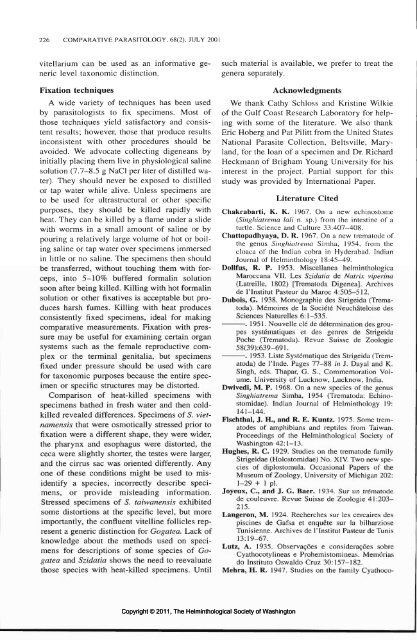Comparative Parasitology 68(2) 2001 - Peru State College
Comparative Parasitology 68(2) 2001 - Peru State College
Comparative Parasitology 68(2) 2001 - Peru State College
Create successful ePaper yourself
Turn your PDF publications into a flip-book with our unique Google optimized e-Paper software.
226 COMPARATIVE PARASITOLOGY, <strong>68</strong>(2), JULY <strong>2001</strong><br />
vitellarium can be used as an informative generic<br />
level taxonomic distinction.<br />
Fixation techniques<br />
A wide variety of techniques has been used<br />
by parasitologists to fix specimens. Most of<br />
those techniques yield satisfactory and consistent<br />
results; however, those that produce results<br />
inconsistent with other procedures should be<br />
avoided. We advocate collecting digeneans by<br />
initially placing them live in physiological saline<br />
solution (7.7—8.5 g NaCl per liter of distilled water).<br />
They should never be exposed to distilled<br />
or tap water while alive. Unless specimens are<br />
to be used for ultrastructural or other specific<br />
puiposes, they should be killed rapidly with<br />
heat. They can be killed by a flame under a slide<br />
with worms in a small amount of saline or by<br />
pouring a relatively large volume of hot or boiling<br />
saline or tap water over specimens immersed<br />
in little or no saline. The specimens then should<br />
be transferred, without touching them with forceps,<br />
into 5—10% buffered formalin solution<br />
soon after being killed. Killing with hot formalin<br />
solution or other fixatives is acceptable but produces<br />
harsh fumes. Killing with heat produces<br />
consistently fixed specimens, ideal for making<br />
comparative measurements. Fixation with pressure<br />
may be useful for examining certain organ<br />
systems such as the female reproductive complex<br />
or the terminal genitalia, but specimens<br />
fixed under pressure should be used with care<br />
for taxonomic purposes because the entire specimen<br />
or specific structures may be distorted.<br />
Comparison of heat-killed specimens with<br />
specimens bathed in fresh water and then coldkilled<br />
revealed differences. Specimens of S. vietnamensis<br />
that were osmotically stressed prior to<br />
fixation were a different shape, they were wider,<br />
the pharynx and esophagus were distorted, the<br />
ceca were slightly shorter, the testes were larger,<br />
and the cirrus sac was oriented differently. Any<br />
one of these conditions might be used to misidentify<br />
a species, incorrectly describe specimens,<br />
or provide misleading information.<br />
Stressed specimens of 5. taiwanensis exhibited<br />
some distortions at the specific level, but more<br />
importantly, the confluent vitelline follicles represent<br />
a generic distinction for Gogatea. Lack of<br />
knowledge about the methods used on specimens<br />
for descriptions of some species of Gogatea<br />
and Szidatia shows the need to reevaluate<br />
those species with heat-killed specimens. Until<br />
Copyright © 2011, The Helminthological Society of Washington<br />
such material is available, we prefer to treat the<br />
genera separately.<br />
Acknowledgments<br />
We thank Cathy Schloss and Kristine Wilkie<br />
of the Gulf Coast Research Laboratory for helping<br />
with some of the literature. We also thank<br />
Eric Hoberg and Pat Pilitt from the United <strong>State</strong>s<br />
National Parasite Collection, Beltsville, Maryland,<br />
for the loan of a specimen and Dr. Richard<br />
Heckmann of Brigham Young University for his<br />
interest in the project. Partial support for this<br />
study was provided by International Paper.<br />
Literature Cited<br />
Chakrabarti, K. K. 1967. On a new echinostome<br />
(Singhiatrema lali n. sp.) from the intestine of a<br />
turtle. Science and Culture 33:407-408.<br />
Chattopadhyaya, D. R. 1967. On a new trematode of<br />
the genus Singhiatrema Simha, 1954, from the<br />
cloaca of the Indian cobra in Hyderabad. Indian<br />
Journal of Helminthology 18:45-49.<br />
Dollfus, R. P. 1953. Miscellanea helminthologica<br />
Maroccana VII. Les Szidatia de Matrix viperina<br />
(Latreille, 1802) [Trematoda Digenea]. Archives<br />
de 1'Institut Pasteur du Maroc 4:505-512.<br />
Dubois, G. 1938. Monographic des Strigeida (Trematoda).<br />
Memoires de la Societe Neuchateloise des<br />
Sciences Naturelles 6:1—535.<br />
. 1951. Nouvelle cle de determination des groupes<br />
systematiques et des genres de Strigeida<br />
Poche (Trematoda). Revue Suisse de Zoologie<br />
58(39):639-691.<br />
-. 1953. Liste Systcmatique des Strigeida (Trematoda)<br />
de 1'Inde. Pages 77-88 in J. Dayal and K.<br />
Singh, eds. Thapar, G. S., Commemoration Volume.<br />
University of Lucknow, Lucknow, India.<br />
Dwivedi, M. P. 19<strong>68</strong>. On a new species of the genus<br />
Singhiatrema Simha, 1954 (Trematoda: Echinostomidae).<br />
Indian Journal of Helminthology 19:<br />
141-144.<br />
Fischthal, J. H., and R. E. Kuntz. 1975. Some trernatodes<br />
of amphibians and reptiles from Taiwan.<br />
Proceedings of the Helminthological Society of<br />
Washington 42:1-13.<br />
Hughes, R. C. 1929. Studies on the trematode family<br />
Strigeidae (Holostomidae) No. XIV. Two new species<br />
of diplostomula. Occasional Papers of the<br />
Museum of Zoology, University of Michigan 202:<br />
1-29 + 1 pi.<br />
Joyeux, C., and J. G. Baer. 1934. Sur un trematode<br />
de couleuvre. Revue Suisse de Zoologie 41:203-<br />
215.<br />
Langeron, M. 1924. Recherches sur les cercaires des<br />
piscines de Gafsa et enquete sur la bilharziose<br />
Tunisienne. Archives de FInstitut Pasteur de Tunis<br />
13:19-67.<br />
Lutz, A. 1935. Observances e consideracoes sobre<br />
Cyathocotylineas e Prohemistomineas. Memorias<br />
do Institute Oswaldo Cruz 30:157-182.<br />
Mehra, H. R. 1947. Studies on the family Cyathoco-
















